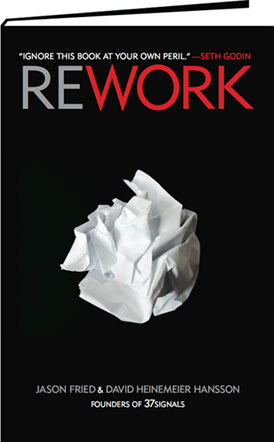Making Ideas Happen vs. Rework
We pit two new forward-thinking business books against each other to see what we can learn


Sharing release dates within weeks of each other, premises that promise success in business, and even covers with red-white-and-black color schemes, our colleague Scott Belsky’s book “
Making Ideas Happen” and “
Rework” have more than a little in common. The two—Belsky as the founder and CEO of Behance, a company devoted to enabling creative professionals, and Rework as the product of 37signals, also a creator of productivity-enhancing tools—both represent a new generation steeped in Internet culture and the fresh vision of capitalism that comes with it, but their approaches come across as markedly different.
While “Making Ideas Happen” represents Belsky’s tireless years of researching the techniques that make companies successful, Rework’s appeal comes from authors and 37signals founders Jason Fried and David Heinemeier Hansson’ direct, mincing-no-words style, outlining the directives they’ve found to work. In lieu of reviews on each, we put together this side-by-side comparison of some of their core principles to see what we could glean. “Rework” sells from Amazon or Powell’s.
1. Working
Much of Belsky’s mission is about getting people organized and finding ways to do it. His tips for staying focused involve stripping out work that isn’t goal-focused, creating rituals to “out-work” the competition to quote ad exec Roy Spence, and tailoring workspaces. Rework, on the other hand, flat out discourages workaholism, criticizing the atmosphere of guilt and burnouts that it creates.
2. Entrepreneurs
Fried and Hansson dismiss “entrepreneur” as a stale-sounding word that doesn’t really define what’s important. Instead, they encourage thinking of yourself as a “starter” as a way to get beyond the usual formulas and focus on the confidence necessary to go ahead. MIH positions entrepreneurship as both a way to make a business think longterm and to make them bravely take the plunge and embark on new ventures (i.e. be starters).
3. Love
What Rework defines as “scratching your own itch”—pursuing a curiosity, or taking something you already do further—Belsky looks at as a potential way to set yourself up for disappointment. He warns of the problems inherent to having a passion for something, advising to stay focused on the process in the face of outcomes that don’t reflect the original inspiration for it.
4. Culture
Citing Zappos as one of a few examples of how to keep work environments positive, MIH explains how the company actively fosters happiness as a way to authentically create the rah-rah attitude that’s core to the success of their service-based business. Fried and Hansson also recognize the importance of “truly standing for something,” cautioning against coming across as insincere when you’re not backing up the mission with “believing it and living it.”

5. Negativity
Both books recognize the value of saying no and embracing constraints. Belsky explains how embracing limits helps cut down on wasted efforts, while Rework describes cutting “ambition in half” as a way to more successfully execute. Rework goes so far as to suggest that saying no should be a default.
6. Action
Where MIH focuses on organizing work flow into actionable steps, Rework pushes the bolder moves, encouraging an attitude of “launch now” as a way to prioritize what needs to happen. Similarly, Belsky cites Seth Godin’s talk at The 99% Conference (an event we co-sponsor with Behance), which encouraged people to center their work around the proactive approach of “shipping.”
7. Meetings
Another point both books agree on is the problems inherent to meetings. Where Belsky advises dispensing with regularly-scheduled meetings, ending by going over “Action Steps,” and conducting them on the fly, Rework suggests setting timers, limiting the number of people who attend, setting agendas, and working from a problem.
8. Priorities
In MIH, Belsky offers tips that include keeping one list for more important items and others for less critical to-dos, picking five top projects, making daily “focus areas,” not spending too much time worrying, making sure to delegate critical tasks too, and creating a system to divvy up responsibilities appropriately. Fried and Hansson’s less structured approach advises tempering excitement with what actually needs to get done.
9. Inspiration
While Belsky’s focus is all about “overcoming the obstacles between vision and reality,” Rework ultimately encourages readers to act when the idea strikes to capitalize on the potential of getting “two week’s work dones in twenty-four hours” when under the spell of ideas.









